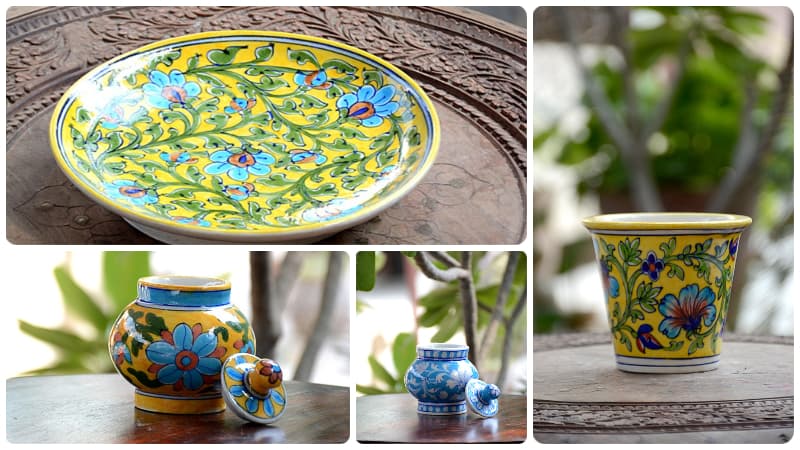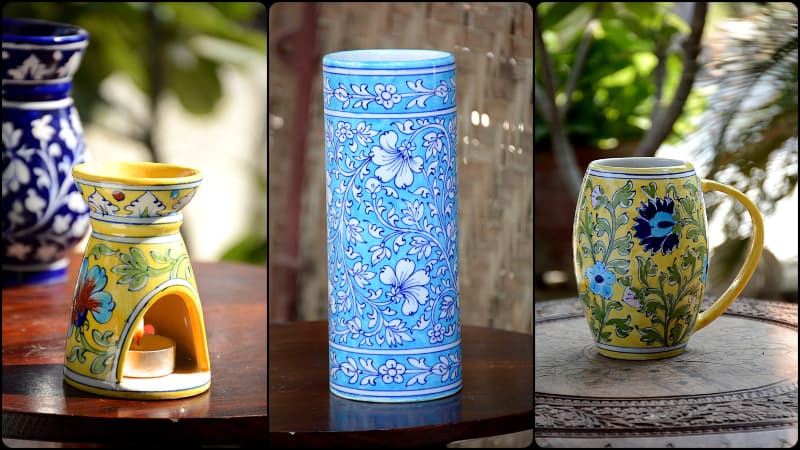Blue Pottery took an interesting route in finding its home in Jaipur. His Highness Maharaja Sawai Ram Singh II once attended a kite flying session and watched two brothers from Achnera bring down the royal kites of his kite masters. Intrigued, he found the secret; they were potters by profession and had coated their strings with the same blue-green glass that they used for their pots. Sawai Ram Singh II was impressed so he invited the brothers to stay in Jaipur and teach this unique form of glazed pottery at his new art school.

The term ‘Blue Pottery’ comes from the brilliantly bright & eye-catching Persian blue dye used to dye the ceramic
The Verge of Extinction
Blue Pottery had enormous potential and should have flourished, but over the years master potters refused to share their trade secrets with their fellow craftsmen so there was an eventual lowering of standards and a gradual dying out of the craft. The new generation is not interested in learning the art. The manufacturing process of Blue pottery is also very complex due to which production and demands are very unequal. By the year 1950, the art was completely washed away and was reintroduced by the efforts of muralists and painter Kripal Singh Shekhawat with the help and support of craft revivalist Kamaladevi Chattopadhyay and Her Highness Maharani Gayatri Devi thus began the Renaissance.
The Craft
It is the only pottery in the world which does not use clay in its ingredients. Blue pottery products are made out of an Egyptian paste which is composed of powdered glass, quartz stone powder, borax, Multani mitti (fuller’s earth) and water. The making starts with the moulding of dough as per the desired requirements. When the dough acquires the needed shape as of moulds it is left to dry for one or two days. After the finishing is done with brass stone, sandpaper, and water. Then come to the designing process where various kinds of animal or flower motifs are drawn. The solution which is used for designing is a mixture of copper oxide and gum and thus it gains its blue colour because of copper oxide. Once the paint is dried glazing is done. Paint glaze is achieved by mixing powdered glass, zinc oxide, borax, potassium nitrate, boric acid in maida(flour) and water. At last, they are fired at a low temperature in a brick kiln for 4 hours and are then kept for cooling for the following few days.
A BRIEF TALK WITH THE MAKER:
We caught up with Ankit Sharma to hear more about his brand and try to know his approach towards Blue Pottery.
1. When was the Blue Jaipur brand was established?
The brand was established in the year 2014 and the major reason behind the establishment was to promote ‘Blue Pottery’ not only as a product but also as the desired object which everybody wants to have it.
2. How many artisans are involved with the brand?
There are 7 artisans, 3 women, and 4 men.
3. Traditionally the women of the house had a role like grinding and the men used to undertake the throwing and moulding part as their in making of the product. Do they still follow it?
No, women, these days are more independent and are not bound to do one job. So it’s not like that the duties are distributed rather the process of making the product is equally been done by both of them.
4. How your brand is helping the artisans and what kind of relief you provide?
We basically choose our artisans from the remote Kumhar (potter) villages so that they can know what kind of products are been made these days and how design intervention can help in improving their skills. We provide relief in work i.e. the person can work from home and gets equal pay without marking them absent.
Check out the other interesting handmade, handcrafted pots from our online store.









































